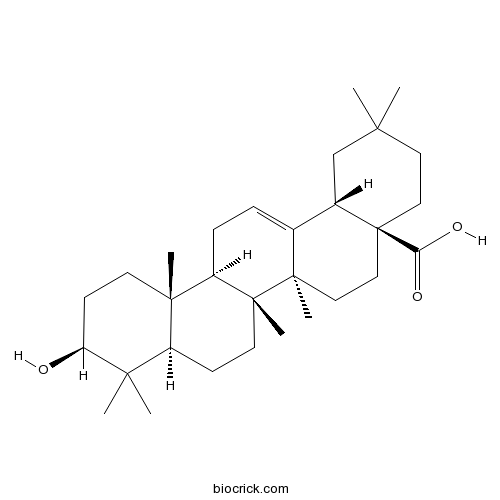Callicarpa longissima
Callicarpa longissima
1. The products in our compound library are selected from thousands of unique natural products; 2. It has the characteristics of diverse structure, diverse sources and wide coverage of activities; 3. Provide information on the activity of products from major journals, patents and research reports around the world, providing theoretical direction and research basis for further research and screening; 4. Free combination according to the type, source, target and disease of natural product; 5. The compound powder is placed in a covered tube and then discharged into a 10 x 10 cryostat; 6. Transport in ice pack or dry ice pack. Please store it at -20 °C as soon as possible after receiving the product, and use it as soon as possible after opening.
Natural products/compounds from Callicarpa longissima
- Cat.No. Product Name CAS Number COA
-
BCN5616
Oleanolic acid508-02-1
Instructions

Rapid analysis of Callicarpa L. using direct spray ionization mass spectrometry.[Pubmed: 26938160]
Direct spray such as leaf spray and paper spray ionization mass spectrometry (MS) is a powerful type of ambient MS for phytochemical analysis. In this paper, direct spray MS methods to rapidly distinguish and analyze five species of Callicarpa L. have been developed. To distinguish species, leaf spray MS was employed to directly analyze leaves. A small triangular leaf sample was wetted with 15 μL of spray solvent and a high DC voltage was then simply applied to the wet leaf sample, which was positioned in front of the inlet of a mass spectrometer to produce electrospray ionization. The MS signals of phenylpropanoid glycosides, i.e. forsythiaside B, poliumoside, verbascoside in leaves could be sensitively detected. The content characteristics of the phenylpropanoid glycosides in five species including Callicarpae kwangtungensis Folium, Callicarpae macrophyllae Folium, Callicarpa nudiflora Folium, Callicarpae formosanae Folium, Callicarpa longissima Folium could be used to distinguish them, then the mass spectra of the Callicarpa L. samples were analyzed using principal component analysis(PCA) or partial least squares-discriminant analysis(PLS-DA). For the rapid semi-quantitative analysis, of phenylpropanoid glycosides in leaves, paper spray MS was employed to determine phenylpropanoid glycosides in the extracts of Callicarpa L. leaves. Ginsenoside Rg1 was selected as an internal standard (I.S.). The calibration curves were constructed through ratios of target ion abundance to I.S. ion abundance vs. concentration of targets. The linearity range was 8-250 μg/mL (R(2)=0.9947) for forsythiaside B, 9-280 μg/mL (R(2)=0.9939) for verbascoside, and 9-260 μg/mL (R(2)=0.9917) for poliumoside, respectively. The limit of detection (LOD) was 1 μg/mL, 0.5 μg/mL and 1 μg/mL for forsythiaside B, verbascoside, and poliumoside, respectively.
Callicarpa longissima extract, carnosol-rich, potently inhibits melanogenesis in B16F10 melanoma cells.[Pubmed: 26267810]
Cosmetic industries focus on developing materials and resources that regulate skin pigmentation. Melanin, the major pigment in human skin, protects the skin against damage from ultraviolet light. An ethanolic extract of the leaves of Callicarpa longissima inhibits melanin production in B16F10 mouse melanoma cells by suppressing microphthalmia-associated transcription factor (MITF) gene expression. Following purification and analysis using liquid chromatography-mass spectrometry (LC-MS), NMR, and biochemical assays, carnosol was determined to be responsible for the major inhibitory effect of the C. longissima extract on melanin production. Carnosol is an oxidative product of carnosic acid, whose presence in the extract was also confirmed by an authentic reference. The carnosol and carnosic acid content in the extract was approximately 16% (w/w). These results suggest that C. longissima is a novel, useful, and attractive source of skin-whitening agents.
Bioactive diterpenes from Callicarpa longissima.[Pubmed: 22429052]
Investigation of the leaves and twigs of Callicarpa longissima resulted in the isolation of four new compounds (1-4), callilongisins A-D, and five known compounds, ursolic acid, 3-oxoanticopalic acid, (E)-6β-hydroxylabda-8(17),13-dien-15-oic acid, 5-hydroxy-3,6,7,4'-tetramethoxyflavone, and artemetin. Compounds 1-3 are 3,4-seco-abietane-type diterpenoids, and compound 4 is an analogue of a labdenoic-type diterpene. The structure of compound 1 was confirmed by X-ray crystallographic analysis. Cytotoxicity against a human prostate cancer cell line (PC3) and anti-inflammatory activities of the isolated compounds were evaluated.


